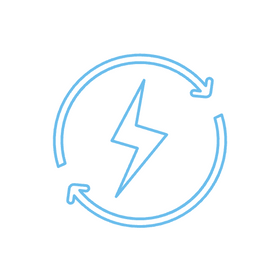How do solar panels work?
Solar panels work by converting sunlight into electricity through the use of photovoltaic (PV) cells. PV cells are made of semiconductor materials that absorb photons (particles of light) and release electrons, creating a flow of electricity. The electricity generated by the PV cells is in the form of direct current (DC) electricity, which is then converted into alternating current (AC) electricity by an inverter, making it usable by homes and businesses.
How much energy can solar panels produce?
The amount of energy produced by solar panels varies depending on several factors. One of the most important factors is the wattage of the solar panels. The higher the wattage rating of a panel, the more energy it can produce. For instance, a 300W panel will produce more energy than a 200W panel. Another important factor is the efficiency of the solar panels. Higher efficiency panels can convert more sunlight into electricity than lower efficiency panels. For example, a panel with an efficiency rating of 20% will produce more energy than a panel with an efficiency rating of 15%. The amount of energy produced by solar panels depends on several factors, including the panel's wattage, efficiency, location, and the amount of sunlight it receives. A standard 60-cell solar panel with a wattage rating of 300 watts peak (Wp) can produce about 1,200 kilowatt-hours (kWh) of energy per year in areas with ample sunlight, such as California or Arizona. However, in areas with less sunlight, such as the Northeast, the same panel may produce only around 900 kWh per year. The location of the solar panels is also crucial. Areas with higher levels of sunlight, such as the Southwest region of the United States, will produce more energy than areas with lower levels of sunlight, such as the Pacific Northwest. Finally, the amount of energy produced by a solar panel system depends on the amount of sunlight the panels receive. A system that is shaded for a significant portion of the day will produce less energy than a system that receives direct sunlight for most of the day.
What size solar panel do I need for my home?
The size of the solar panel system you need for your home depends on your energy needs and the available roof space. To determine the appropriate size for your home, you can use an online solar panel calculator or consult with a solar panel professional. They will consider factors such as your current energy consumption, the angle and orientation of your roof, and local climate conditions to help you choose the right size system for your needs.
What is the difference between on-grid and off-grid solar systems?
On-grid solar systems are connected to the utility grid and allow you to use electricity from the grid when solar power is insufficient. Off-grid solar systems are not connected to the utility grid and rely solely on solar energy and batteries for power. On-grid systems are the most common type of solar panel system in the United States. They are designed to work in tandem with the utility grid, which means that when your solar panels produce excess electricity, it is fed back into the grid and you receive credit for the excess energy. On the other hand, when your solar panels do not produce enough electricity to meet your needs, you can draw electricity from the grid. Off-grid systems are used in remote locations where access to the utility grid is not available or is prohibitively expensive. These systems require a battery bank to store excess energy for use when the sun is not shining. Off-grid systems are typically more expensive than on-grid systems because they require more equipment.
What is a solar battery and do I need one?
A solar battery is a device that stores excess energy generated by solar panels for use when sunlight is not available, such as at night or during cloudy weather. Solar batteries are not necessary for all solar panel systems, but they can be beneficial for those who want to maximize their energy independence and reduce their reliance on the utility grid.
How long do solar panels last?
Solar panels typically come with a 25-year warranty, but they can last up to 30 years or more with proper maintenance. Factors that can affect the lifespan of solar panels include the quality of the panels, installation, weather conditions, and maintenance. The longevity of a solar panel depends on several factors, including the quality of the panel, the installation, and the weather conditions.
How much maintenance do solar panels require?
Solar panels require minimal maintenance, but it is recommended to have them inspected annually to ensure optimal performance. This may include cleaning the panels to remove dirt and debris, checking the wiring and connections, and trimming any nearby trees or vegetation that could cause shading.
What is the return on investment for a solar panel system?
The return on investment (ROI) for a solar panel system depends on several factors, including the cost of the system, the amount of energy it can generate, and the cost of electricity in your area. Generally, homeowners can expect to recoup the cost of their solar panel system within 5 to 10 years and see significant savings on their electricity bills over the lifetime of the system.
How do I know if my home is a good candidate for solar panels?
Determining whether your home is a good candidate for solar panels requires a few key considerations. First, you'll want to evaluate the amount of sunlight your roof receives throughout the day and throughout the year, as this will directly impact the amount of energy your solar panels can generate. Additionally, you'll want to assess the size and angle of your roof to ensure that it is large enough to accommodate the necessary number of solar panels and that it is angled in a way that maximizes sun exposure. You'll also want to consider the local climate, as homes in areas with high levels of precipitation or heavy cloud cover may not be as well-suited for solar energy production. Finally, you'll want to evaluate your energy needs and consumption patterns to determine whether the cost of installing solar panels is justified by the potential savings on your energy bills.
How many solar panels do I need to power my home?
The number of solar panels you need to power your home depends on several factors, including your daily energy consumption, the size of your home, and the efficiency of your solar panels. To estimate the number of panels you need, you will need to calculate your daily energy usage in kilowatt-hours (kWh). This information can usually be found on your utility bill. Once you have your daily usage, you can divide that number by the average daily output of a solar panel in your area. For example, if your home uses 30 kWh per day and the average daily output of a solar panel in your area is 4 kWh, you would need about 8 solar panels to power your home.
What is the difference between on-grid and off-grid solar systems?
An on-grid solar system is connected to the utility grid, allowing you to use electricity from the grid when solar power is insufficient, and vice versa. Off-grid systems, on the other hand, are not connected to the utility grid, and instead rely solely on solar energy and batteries for power.
What is the difference between monocrystalline and polycrystalline solar panels?
What is the difference between monocrystalline and polycrystalline solar panels? Monocrystalline solar panels are made from a single crystal of silicon, while polycrystalline panels are made from multiple crystals of silicon. Monocrystalline panels are more efficient and produce more energy per square foot, but are also more expensive. Polycrystalline panels are more cost-effective but are less efficient and produce less energy per square foot.
Can solar panels work in cloudy weather?
Yes, solar panels can still produce energy in cloudy weather, but at a reduced efficiency. The amount of energy produced depends on the density and duration of the cloud cover.
Do I need a solar battery if I have solar panels?
A solar battery is not required if you have a grid-tied solar system, as excess energy can be fed back into the utility grid. However, a solar battery can be beneficial for off-grid systems or in areas with frequent power outages, as it allows you to store excess energy for later use.
How much does a solar panel system cost?
The cost of a solar panel system varies depending on its size, location, and the equipment used. A typical residential solar panel system can cost between $10,000 and $25,000, but this can be offset by state and federal incentives and long-term energy savings.
What incentives are available for solar panel installations?
There are several incentives available for solar panel installations, including federal tax credits, state and local incentives, and net metering programs. The federal solar tax credit allows homeowners to claim a credit of up to 26% of the cost of a solar panel system.
What is a capacitor?
A capacitor is a type of electronic component that is used to store electrical energy in an electric field. It consists of two metal plates that are separated by a non-conductive material, called a dielectric. When a voltage is applied across the plates, an electric field is created, and charge is stored on the plates. The amount of charge that a capacitor can store, known as its capacitance, is measured in units called farads. Capacitors are commonly used in a wide range of electronic devices and systems, including solar energy systems. They are used to regulate voltage, filter out unwanted noise or signals, and store energy for later use. In a solar energy system, capacitors are used to store energy generated by the solar panels and to deliver that energy to the electrical system in a controlled manner. There are many different types of capacitors available, each with their own characteristics and applications. Some of the most common types of capacitors include electrolytic capacitors, ceramic capacitors, tantalum capacitors, and film capacitors. When selecting a capacitor for a specific application, it's important to consider factors such as capacitance, voltage rating, and temperature rating, as well as the specific requirements of the system in which the capacitor will be used.
Is a capacitor another name for a battery? if not, what is the difference?
No, a capacitor is not another name for a battery, although both are used to store electrical energy. There are several differences between capacitors and batteries: Energy storage capacity: Capacitors are typically able to store less energy than batteries. While batteries are designed to store energy for long periods of time, capacitors are designed to quickly store and release energy in short bursts. Charging and discharging rates: Capacitors are able to charge and discharge much more quickly than batteries, which makes them well-suited for applications that require rapid energy delivery. Lifespan: Batteries tend to have a longer lifespan than capacitors, and are able to withstand more charge and discharge cycles before their performance starts to degrade. Chemical composition: Batteries are chemical devices that rely on chemical reactions to store and release energy, while capacitors are purely electronic devices that rely on the storage of electrical charge. In summary, while capacitors and batteries are both used to store electrical energy, they have different characteristics and are best suited for different types of applications. Capacitors are ideal for applications that require rapid energy delivery, while batteries are better suited for applications that require long-term energy storage.
What type of capacitor should I use?
When looking to invest in solar energy products, it's important to understand the different types of capacitors available, as they play a crucial role in the storage and delivery of electricity in a solar system. In the world of capacitors, there are four main types: ultracapacitors, heavy capacitors, medium capacitors, and light capacitors. Ultracapacitors, also known as ""ultracaps,"" are a type of capacitor that can store and discharge electrical energy much faster than traditional batteries. They are ideal for applications where rapid charge and discharge rates are required, such as regenerative braking systems in electric vehicles or in backup power systems for critical infrastructure. Ultracapacitors are more expensive than other types of capacitors, but they offer a longer lifespan and greater reliability. Heavy capacitors, as the name suggests, are capacitors that are designed for high voltage and high current applications. They are typically used in applications where large amounts of energy need to be stored and discharged quickly, such as in power electronics or renewable energy systems. Heavy capacitors are often made from materials such as tantalum, aluminum, or ceramic, and they are more expensive than other types of capacitors due to their high energy storage capacity. Medium capacitors are a type of capacitor that falls in between heavy capacitors and light capacitors in terms of energy storage capacity. They are used in a wide range of applications, from consumer electronics to automotive systems. Medium capacitors are typically made from materials such as plastic or ceramic, and they are less expensive than heavy capacitors. Finally, light capacitors, also known as ""lightcaps,"" are a type of capacitor that is designed for low voltage and low current applications. They are commonly used in applications such as flashlights, toys, and small electronic devices. Light capacitors are typically made from materials such as aluminum, tantalum, or plastic, and they are the least expensive type of capacitor. When deciding which type of capacitor to use in a solar energy system, it's important to consider factors such as energy storage capacity, cost, and reliability. It's also important to work with a reputable solar energy supplier who can help you choose the right type of capacitor for your specific needs.



